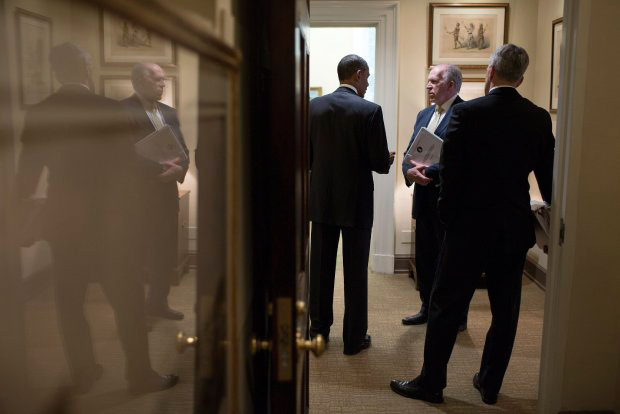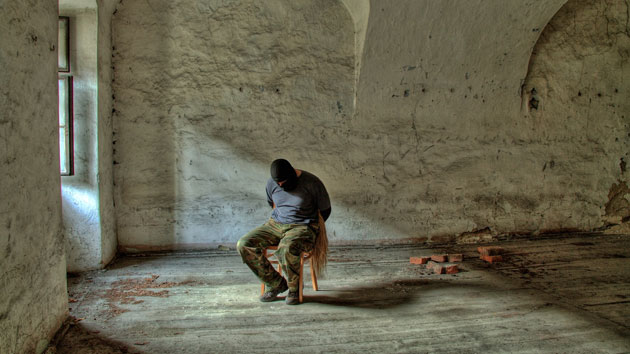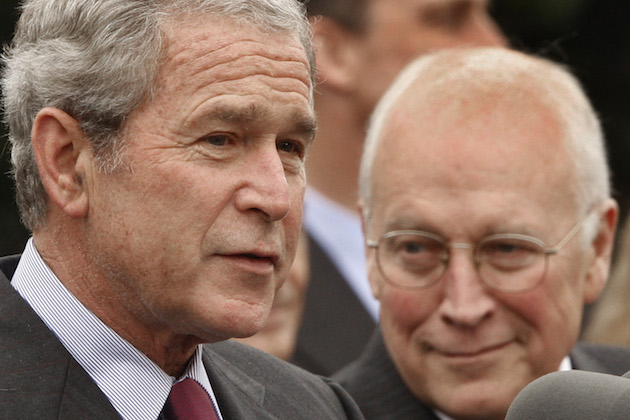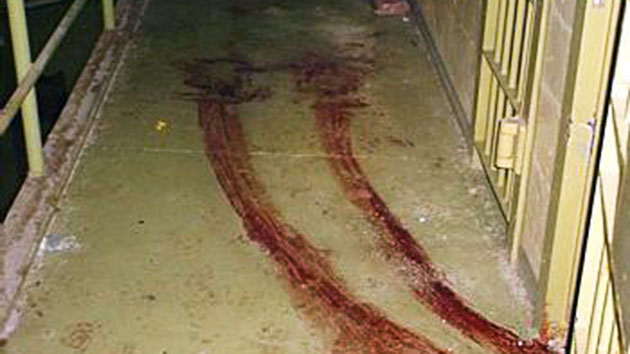This story originally appeared on ProPublica.
The Senate began investigating the CIA’s detainee program nearly six years ago. It completed a draft of its report two years ago. Today, the Senate Intelligence Committee has finally released the report’s blistering executive summary. (The full report remains classified.) What took so long? It’s a tale of White House indecisiveness, Republican opposition, and CIA snooping.
It’s January 2009. Obama takes office. Within days, he shuts down the CIA’s detainee program. But he says he’d rather not dwell on the past.
January 11, 2009: President-elect Barack Obama tells George Stephanopoulos he’s not interested in a broad investigation of Bush-era intelligence programs, saying, “We need to look forward as opposed to looking backwards.”
January 22, 2009: Obama issues an executive order banning the use of torture.
However, the Senate Intelligence Committee wants to investigate. Lawmakers say they expect to conclude their inquiry sometime between August 2009 and March 2010.
February 27, 2009: On the condition of anonymity, Senate officials tell reporters that the intelligence committee plans to probe the CIA’s detainee program. The Associated Press reports that the review will take six months to a year.
March 5, 2009: The panel votes 14-1 to proceed with the investigation. Committee chair Sen. Dianne Feinstein, D-Calif., and vice chair Kit Bond, R-Mo., formally announce the investigation. The press release says the review should take one year.
Then Obama signals he might reverse course and prosecute CIA employees involved in torture. The Senate investigation starts going off the rails.
April 16, 2009: Attorney General Eric Holder releases four of the Bush administration’s legal opinions sanctioning “enhanced interrogation.” Obama says he will not prosecute the CIA employees who acted on the Justice Department’s orders and “nothing will be gained by spending our time and energy laying blame for the past.”
April 20, 2009: Feinstein asks Obama to “withhold judgment” on CIA prosecutions until the committee review is finished. “This study is now underway, and I estimate its completion within the next six to eight months,” she writes to the president. “A study of the first two detainees has already been completed and will shortly be before the committee.”
The same day, then-CNN White House correspondent Ed Henry tells “Lou Dobbs Tonight” the report should take six to eight months to complete, but “obviously a lot of people [are] looking for it to happen a little bit quicker since this has been going on for a long time.”
April 21, 2009: Obama suggests he might be open to prosecutions. “With respect to those who formulated those legal decisions, I would say that is going to be more of a decision for the Attorney General within the parameters of various laws and I don’t want to prejudge that,” Obama says. “I think that there are a host of very complicated issues involved there.”
Mid-2009: The CIA creates a secure facility where congressional aides will be allowed to view the documents related to the investigation. Feinstein later says the CIA provided a “stand-alone computer system” that was “segregated from CIA networks.”
Aides start sorting through six million pages of documents. The process is initially slow because the CIA hires contractors to read each document before giving it to the committee, to ensure the Senate aides don’t get access to sensitive documents unrelated to the detainee program. “This proved to be a slow and very expensive process,” Feinstein later says.
August 24, 2009: Holder opens a “preliminary review” into potential prosecutions.
The next week, Feinstein tells “Face the Nation” she wishes the Justice Department would wait for the committee to complete its report.
“We’re well along in that study,” Feinstein says. “And I’m trying to push it along even more quickly.”
September 26, 2009: Republicans on the committee withdraw from the panel’s review. They say the Justice Department’s concurrent investigation will make CIA employees afraid to answer the committee’s questions.
“Had Mr. Holder honored the pledge made by the President to look forward, not backwards, we would still be active participants in the committee’s review,” Bond says in a statement.
Feinstein says the committee’s investigation will continue without the Republicans’ support.
Senate aides notice some fishy things happening at the CIA. The committee blows past its projected deadline.
February 2010: Around this time, about 870 documents disappear from the computers in the CIA facility where congressional aides are conducting the investigation, Feinstein later alleges.
May 2010: Another 60 documents allegedly go missing. As Feinstein tells it, CIA personnel first deny that the documents are missing, then blame the IT contractors, then blame the White House. The White House says it did not tell the CIA to remove the documents.
May 17, 2010: The CIA apologizes for removing the documents, Feinstein later says.
At some point in 2010: According to Feinstein, around this time, aides discover the “Panetta Review” – an internal report written for then-director Leon Panetta that acknowledges “significant CIA wrongdoing.”
She says “some time after” aides find the Panetta Review, those documents disappear from the computers too.
The committee keeps working. The Justice Department closes its inquiry without pursuing prosecutions. In 2012, the committee starts hinting at the report’s findings. New ETA: Soon. Real soon.
June 30, 2011: After a preliminary review, the Justice Department’s special prosecutor clears CIA employees of wrongdoing in 99 cases of alleged detainee mistreatment. He recommends that the Justice Department investigate just two cases of detainee deaths.
April 27, 2012: Reuters reports that the committee has found “no evidence” that CIA torture led to any significant intelligence breakthroughs. At this point, the report is still being finalized.
April 30, 2012: Feinstein and Sen. Carl Levin, D-Mich., issue a press release saying the CIA’s “enhanced interrogation techniques” did not help the government find Osama bin Laden. They say the committee will complete its review “soon.”
August 30, 2012: Attorney General Eric Holder announces he is not prosecuting any CIA employees for detainee deaths.
September 6, 2012: The New York Times reports that the committee’s review is “nearing completion.”
In December 2012, the committee votes to start the declassification process. Now lawmakers just need the CIA to provide its comments on the report, and then the committee can vote again about which parts should be released.
December 13, 2012: The committee votes 9-6 to approve the report for the declassification process. Feinstein says the report is more than 6,000 pages long.
Committee co-chair Sen. Saxby Chambliss, R-Ga., votes against approving the report. He says the report contains “significant errors, omissions, assumptions and ambiguities – as well as a lot of cherry-picking.”
But the report isn’t declassified right away — the first step is to send the report to the White House, the CIA and other federal agencies for their comment. “After that is complete in mid-February, the committee will vote again on how much of the report should be declassified,” the New York Times reports.
The CIA does not like the report.
January 30, 2013: Sen. Mark Udall, D-Colo., expresses his disappointment that CIA director nominee John Brennan has not yet reviewed the committee’s report.
February 7, 2013: Brennan reads the 300-page summary of the committee’s report in time for his confirmation hearing. He tells the panel, “I must tell you that reading this report from the committee raises serious questions about the information that I was given at the time.”
He adds, “I don’t know what the facts are or what the truth is. So I really need to look at that carefully and see what CIA’s response is.”
February 15, 2013: Comments are due to the committee. Neither the CIA nor the White House submit a response by the deadline.
March 7, 2013: The Senate confirms Brennan as CIA director. An anonymous senior intelligence official tells the Wall Street Journal that the agency objects to most of the committee’s report.
March 26, 2013: Brennan is now responsible for assembling the CIA’s response. Anonymous former senior CIA officials tell the Washington Post that an early draft is “highly critical” and finds “loads of holes” in the committee’s report.
May 7, 2013: Anonymous former officials tell the Washington Post that the CIA is still assembling “a defiant response.”
May 10, 2013: Brennan meets with President Obama and shows him the CIA’s response, the Intercept later reports. White House photographer Pete Souza snaps this photo, which reportedly shows Brennan holding the response:

June 2013: The State Department sends a classified letter urging the committee not to declassify the report. In the letter, then-assistant secretary of state Philip Goldberg warns that if the committee reveals the CIA’s cooperation with foreign intelligence agencies, it could endanger American diplomats and harm foreign relations.
June 27, 2013: The CIA officially responds to the report. The 122-page secret rebuttal reportedly lists errors and criticizes the committee for failing to interview any CIA employees. A committee aide says the panel tried to interview those involved, but the CIA did not cooperate.
The same day, Udall issues a statement accusing intelligence officials of leaking “inaccurate information” critical of the committee’s report. Udall alleges that the CIA and the White House “repeatedly rejected requests to discuss the Committee’s report with Members or Committee staff.”
But the committee thinks the CIA hasn’t properly considered one important piece of evidence – the agency’s own internal report, which allegedly acknowledges CIA wrongdoing. Lawmakers push forward.
Between June 27, 2013, and January 15, 2014: The committee concludes the CIA’s official response is at odds with the Panetta Review, which found evidence of wrongdoing. At some point during this period, congressional aides take printed copies of the Panetta Review out of the secure CIA facility where they have been assembling their research, without the CIA’s permission.
July 19, 2013: Feinstein says she’s leading a push to declassify at least the 300-page executive summary of the report.
Chambliss says he disagrees with the report’s conclusions, but he thinks both the summary and the CIA’s response should be released. He adds that the report is flawed because it relied too heavily on documents. “The folks doing the report got 100 percent of their information from documents and didn’t interview a single person,” he says.
White House spokeswoman Caitlin Hayden says the Obama administration still wants to address some “factual questions,” but the administration thinks “some version of the findings of the report should be made public.”
July 25, 2013: The New York Times predicts the report will be partly declassified “in the next few months.”
November 26, 2013: Nothing has happened. The ACLU files a Freedom of Information Act lawsuit for the committee’s report and the CIA’s response to the report.
Late 2013: Feinstein asks the CIA to give the committee “a final and complete version” of the Panetta Review.
December 17, 2013: Udall publicly discloses the existence of the Panetta Review in a congressional committee hearing. The committee asks the CIA to hand it over.
January 6, 2014: Udall writes to President Obama, asking that the White House compel the CIA to respond to remaining information requests. He also asks for “a public statement from the White House committing to the fullest possible declassification of the Committee’s study in the most expedient and responsible manner possible.”
Early January 2014: The CIA refuses to give the committee the Panetta Review, arguing that the documents are privileged.
The CIA accuses Senate aides of hacking into the agency’s computer networks. The Senate committee accuses the CIA of hacking into its computer networks. The brawl goes public.
January 15, 2014: As Feinstein later recounts, on this day, Brennan calls an “emergency meeting.” He tells her that the CIA searched the committee’s “stand alone” computers for copies of the Panetta Review. He believes committee aides may have obtained the documents through illegal means. Feinstein says the documents were made available on the committee’s computers.
January 17, 2014: Feinstein writes to Brennan and asks him to end his investigation of the Senate committee, citing separation of powers.
Sometime during this chaos: The CIA’s inspector general files a crimes report with the Justice Department about the CIA spying on the Senate.
The CIA’s general counsel files a crimes report with the Justice Department about the Senate spying on the CIA.
March 4, 2014: McClatchy first reports on the feud.
Udall sends another letter to the White House. “As you are aware, the CIA has recently taken unprecedented action against the committee in relation to the internal CIA review and I find these actions to be incredibly troubling for the committee’s oversight responsibilities and for our democracy,” he writes. “It is essential that the committee be able to do its oversight work – consistent with our constitutional principle of the separation of powers – without the CIA posing impediments or obstacles as it is today.”
March 5, 2014: Brennan denies allegations that the CIA spied on committee members. “I am deeply dismayed that some members of the Senate have decided to make spurious allegations about CIA actions that are wholly unsupported by the facts,” Brennan says.
March 11, 2014: Feinstein tells the whole story on the Senate floor. She accuses the CIA of violating “the Fourth Amendment, the Computer Fraud and Abuse Act, as well as Executive Order 12333, which prohibits the C.I.A. from conducting domestic searches or surveillance.”
March 12, 2014: The president says he will not “wade into” the dispute between the committee and the CIA.
March 19, 2014: Senator Majority Leader Harry Reid, D-NV, writes to Brennan and Holder to notify them that the Senate Sergeant-at-Arms will investigate charges that the CIA accessed the committee’s computer network.
March 31, 2014: The Washington Post details the main conclusion of the committee’s report: that the CIA repeatedly and deliberately lied to Congress about torture.
The committee votes to declassify the summary of the report.
April 3, 2014: The report is now more than 6,200 pages, and the executive summary is 481 pages. The committee votes 11-3 to declassify the executive summary and conclusions.
Now it’s up to the CIA to complete its declassification review. The White House says the process will be expedited. Feinstein anticipates it will take just one more month.
April 11, 2014: McClatchy publishes the report’s findings. Among them: torture was not an effective means of acquiring intelligence, the CIA repeatedly misled the Department of Justice, and CIA employees used “interrogation techniques” that had not been approved by CIA headquarters or the Justice Department.
Feinstein says she is opening a new investigation to find out who leaked the findings. “If someone distributed any part of this classified report, they broke the law and should be prosecuted,” she says. “The committee is investigating this unauthorized disclosure, and I intend to refer the matter to the Department of Justice.”
Udall writes to President Obama, asking that the White House oversee the declassification process instead of the CIA.
July 31, 2014: CIA acknowledges that, despite Brennan’s earlier denial about what he called “spurious allegations,” the agency did in fact spy on Senate investigators. An internal agency review found that CIA officers created a false online identity to access to computers used by the investigators and read their emails. The review also said that when CIA officers were first asked about the spying, they showed a “lack of candor.”
August 5, 2014: Release of the report is put on hold after the Senate objects to CIA trying to redact evidence that the agency had misled investigators. “I have concluded the redactions eliminate or obscure key facts that support the report’s findings and conclusions,” said Feinstein.
December 9, 2014: The Senate Intelligence Committee releases the executive summary of the report. It concludes the CIA mislead the public, Congress, and the White House both about the severity of treatment and about effectiveness of torture.















